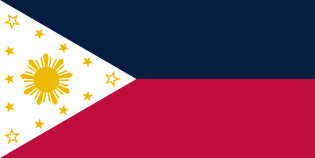Commonwealth of the Philippines
The Commonwealth of the Philippines, sometimes referred to as the Philippine Commonwealth, and commonly known as The Philippines, is a Legacy Nation situated predominantly in the Sea of Clouds. It is a Regional Power, a member of the League of Nations, and a member of the Orion Treaty Organization.
History
Pre-First Scinfaxi War
Modern human activity in the Philippine archipelago on Earth dated to at least 47,000 years ago. The archipelago's earliest inhabitants were followed by waves of Austronesian peoples around 3,000 BCE. The adoption of animism, Hinduism with Buddhist influence, and Islam established island-kingdoms. Extensive overseas trade with neighbors such as the late Tang or Song empire brought Chinese people to the archipelago as well, which would also gradually settle in and intermix over the centuries. The arrival of the European explorers marked the beginning of Spanish colonization. In 1543, the archipelago was Las Islas Filipinas in honor of King Philip II of Castile. Catholicism became the dominant religion, and Manila became the western hub of trans-Pacific trade. Hispanic immigrants from Latin America and Iberia would also selectively colonize. The Philippine Revolution began in 1896, and became entwined with the 1898 Spanish–American War. Spain ceded the territory to the United States, and Filipino revolutionaries declared the First Philippine Republic. The ensuing Philippine–American War, which resulted in the deaths of hundreds of thousands of civilians from famine, disease, and American concentration camps, ended with the United States controlling the territory.
In 1933, the first recorded observation of what would later be called the Scinfaxi Virus was made in the Philippines. The environmental disturbances resulting were used as justification for the delaying of Philippine self-governance by the United States Congress in 1934. In 1935, the first Scinfaxi quarantine zone would be established to protect Iloilo City in the Western Visayas. By the end of the next year, similar quarantines and defensive perimeters would be established around Panay and Roxas City.
References
- "Philippine Marines Destroy Huldra Nest in Far Frontier". Champlain Group.
- "U.S. Approves Sale of Heavy Cruisers To Philippine Commonwealth". Champlain Group.
| Regional Powers of the Orion Arm |
|---|
